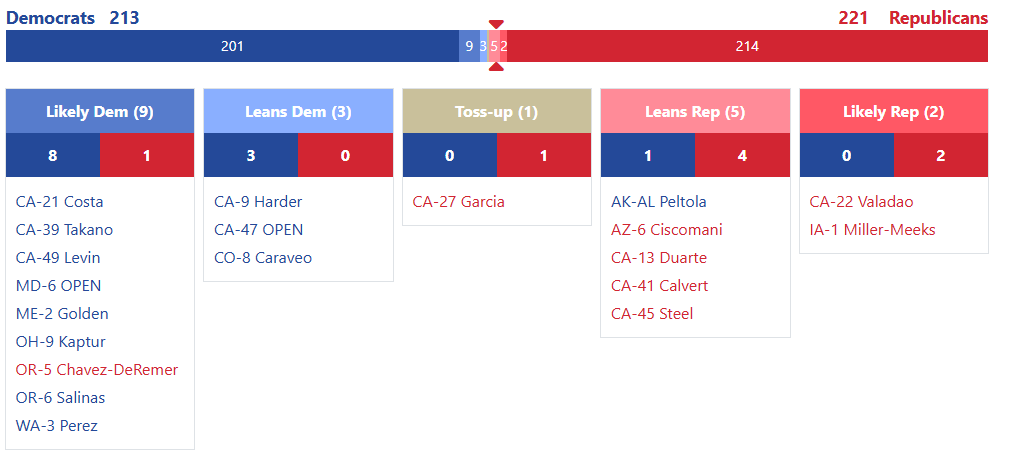This market contains competitive US House Races. The current balance of power is 217 Republican Party members, 214 Democratic Party members, and 5 vacancies.
If a member of the Republican Party wins a house race, then that house race resolves YES in this market. If a member of the Democratic Party wins a race, then that race resolves NO.
If a race is won by someone who is not a member of either party, they will be considered to be a member of the major party they are expected to caucus with. For example, Bernie Sanders would be considered a Democrat and Justin Amash would be considered a Republican.
Races are listed in the format "[district name] [incumbent name] [incumbent party] [margin of victory of incumbent in 2022 election] [Ratings from Cook/Inside/Sabato]"
As of market creation, only the most competitive seats have their margin of victory listed. Additional information and additional races will be added to this market as we get closer to the election.
For additional analysis, you can find projections for these races at Race to The White House, The Cook Political Report, Inside Elections, and Sabato's Crystal Ball.
🏅 Top traders
| # | Name | Total profit |
|---|---|---|
| 1 | Ṁ2,443 | |
| 2 | Ṁ1,075 | |
| 3 | Ṁ980 | |
| 4 | Ṁ895 | |
| 5 | Ṁ853 |
People are also trading
Duarte-only market: https://manifold.markets/dlin007/will-john-duarte-ca13-be-reelected
@ManifoldPolitics @mods @Conflux This one (CA-09) resolves NO :)
The only 7 uncalled races are the other six races in this post, (plus CA-21)!
@PaintspotInfez I resolved a bunch based on CNN projections! I think each of the still-open races is uncalled
@Conflux @ManifoldPolitics @mods OR-05 also resolves as NO
(in addition to CA-22, CA-41, AZ-06, and CO-08 all resolving as YES — and CA-49 resolving as NO)
CA-03, CA-40, CO-03, PA-07, PA-08, WI-03 can resolve YES.
IL-17, MI-03, NC-01, NV-01, NV-03, NV-04, NY-04, OR-04, TX-34, WA-08 can resolve NO.
@mods Lots of these can resolve as YES and NO, since lots of these have been called by all the major outlets.
deleted
There needs to be a better way of organizing this. Ex. doing all the Congressional races in a state. There are too many races on the same page.
So if people wanted to start comments - it wouldn't work. For that you need comments for just a single race. Then people can post news articles, polls, etc.
I lean towards thinking that this is best done as a single market for each race.
@MaybeNotDepends I think the problem with that is that each market doesn't have enough liquidity or is too hard to find. Don't want to have to open a new tab for every market. Maybe just the UI could be better to hide the contract until you click on it. IDK
